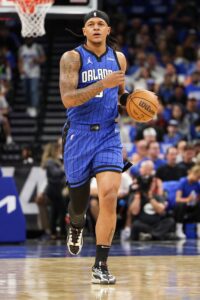After going 22-50 in 2020/21 and 24-58 in ’21/22, the Thunder took a major step forward in their rebuild in ’22/23, finishing 40-42, good for the No. 10 seed in the West. Oklahoma City won its first play-in game that season over New Orleans, but the team was eliminated from postseason contention by Minnesota, which advanced as last season’s No. 8 seed.
A year-over-year increase of 16 wins is pretty rare in the NBA. Yet in 2023/24, the Thunder actually surpassed that total, winning an additional 17 games and finishing 57-25 (they had the same record as Denver but claimed the West’s top seed due to a head-to-head tiebreaker). Oklahoma City finished the regular season third in offensive rating and fourth in defense, for an overall net rating of +7.3, which only trailed the Celtics (+11.7).
In their first playoff run with their young core, the Thunder quickly dispatched the Pelicans in a first-round sweep before falling to the Mavericks in a six-game second-round series. While the outcome was obviously disappointing, it was a competitive series — the two teams scored the exact same number of points. Dallas went on to make the NBA Finals, losing to Boston in five games.
Oklahoma City’s ascent from a rising young team to a legitimate contender was very rapid, spearheaded by the emergence of Shai Gilgeous-Alexander as a MVP candidate — he finished third in the 2024 balloting. Second-year wing Jalen Williams and center Chet Holmgren, who just finished his rookie campaign but has technically been under contract for two years, round out the Thunder’s formidable (and very young) big three.
With Gilgeous-Alexander as the team’s primary ball-handler and Williams a frequent secondary creator, Josh Giddey became expendable. The Mavs dared Giddey to shoot in their second-round series and he struggled defensively as well, later admitting his confidence took a hit. Reigning Coach of the Year Mark Daigneault ultimately moved the former sixth overall pick to the bench, but even before the playoffs, Giddey’s fit going forward was a major question mark.
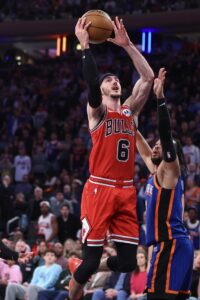 The Thunder are trading Giddey to the Bulls in a one-for-one swap for defensive stalwart Alex Caruso, according to ESPN’s Adrian Wojnarowski. OKC had its sights set on the 30-year-old for a while and the team reportedly views him as a long-term fit. Caruso is on an expiring contract but will be extension-eligible during the season, whereas Giddey will be restricted next year if he doesn’t sign a rookie scale extension with Chicago this offseason.
The Thunder are trading Giddey to the Bulls in a one-for-one swap for defensive stalwart Alex Caruso, according to ESPN’s Adrian Wojnarowski. OKC had its sights set on the 30-year-old for a while and the team reportedly views him as a long-term fit. Caruso is on an expiring contract but will be extension-eligible during the season, whereas Giddey will be restricted next year if he doesn’t sign a rookie scale extension with Chicago this offseason.
It’s worth noting that Caruso has ties to the Thunder, having played for Daigneault while the two were with the Blue — OKC’s NBA G League affiliate — several years ago. Caruso also publicly praised Daigneault back in November.
The move made a lot of sense, as Caruso doesn’t need the ball to be effective and is in a different league as a defender compared to Giddey. He’s also a much better shooter, having made 40.8% of his 4.7 three-point attempts in 2023/24, versus 33.7% (a career-high) on 3.0 attempts for Giddey.
President of basketball operations Sam Presti has been hoarding draft picks for years, so Oklahoma City has plenty of non-player assets to dangle in additional trade talks. The Thunder also project to have $33MM+ in cap room this summer, putting the team in a unique position as a contender who can be a major player in free agency.
The Thunder’s Offseason Plan
The Thunder have Gilgeous-Alexander, three-and-D wing Luguentz Dort, and last year’s 10th pick, Cason Wallace, under team control for at least the next three seasons. The same is true of Kenrich Williams, though his future with OKC seems a little uncertain after his role was reduced this past season. Still, Williams’ contract is relatively team-friendly and he would likely appeal to rival teams if he were made available.
The 2026 offseason is an important one to keep in mind for OKC, as that’s when Holmgren and Jalen Williams will have completed the fourth and final seasons of their rookie scale contracts and will be up for new deals. Based on how they played this past season and factoring in projected growth, it wouldn’t at all be surprising if they both received maximum-salary contracts in the future, whether that comes via extensions in the 2025 offseason or as restricted free agents in 2026.
That means the Thunder have a two-year window to take advantage of their financial flexibility, since it may be the last period in which they’ll have a significant amount of room available for quite some time. The Thunder don’t have to commit long-term money this summer if they don’t want to though — they could preserve flexibility for 2025 by “overpaying” a player or two on short-term deals, similar to what happened with Indiana and Bruce Brown last offseason.
The Pacers gave Brown a two-year, $45MM contract which only features one fully guaranteed season (the second is a team option). They later used him as salary-matching ballast in the trade to acquire Pascal Siakam from the Raptors (Toronto is expected to exercise its $23MM option on Brown and will reportedly look to trade him).
That type of contract structure could be appealing to the Thunder if they want to hedge their bets. The players they sign could be used as salary-matching pieces if the right opportunities present themselves while also (hopefully) being positive contributors for OKC.
Isaiah Hartenstein has been mentioned as a possible free agent target, and he only has Early Bird rights, which means the Knicks are limited to offering him a four-year, $72.5MM deal. One rumor suggested the Thunder might be willing to offer Hartenstein a short-term deal — perhaps two years — with a high salary. Would that appeal to Hartenstein?
Fred Katz of The Athletic recently reported the 26-year-old big man is looking for “long-term security, not high-risk, high-reward instability,” so a deal with just one or two guaranteed years may be a tough sell. If they wanted to, the Thunder could easily offer Hartenstein a three-year deal that matches or exceeds New York’s total, allowing him to hit free agency a year earlier while joining a great team.
Hartenstein would bring a different dynamic to the Thunder as a more “traditional” big man. While I place a high value on the 26-year-old’s game, I don’t necessarily love his fit with Oklahoma City. The main reason for that is the Thunder run a “five-out” offense predicated on everyone being able to handle the ball, pass and shoot. That spacing creates driving lanes for Gilgeous-Alexander and Jalen Williams, and is part of what makes Holmgren so effective as a center. Hartenstein makes good on-ball decisions and is a plus passer for a big man, but he’s essentially a non-shooter.
Of course, that’s just a cursory glance at his potential fit. Hartenstein is also an excellent screener and an unselfish ball mover — a fairly atypical combination for a big man. When they’re at their best, the Thunder are frequently moving, setting screens and back-cutting toward the basket on the weak side. That would seemingly pair well with Hartenstein.
Hartenstein had an excellent all-around season by traditional measures and by advanced statistics. For instance, when he was on the court during the regular season, the Knicks had the equivalent of the NBA’s third-best offense and second-best defense (they were slightly negative when he didn’t play). He ranked seventh in the league in defensive FG% at the rim, ahead of Victor Wembanyama, Brook Lopez and Anthony Davis. He would also improve the Thunder’s rebounding at both ends of the court.
The Thunder’s biggest weakness during the 2023/24 season was on the boards, ranking just 27th in the league in rebounds per game and 28th in rebounding percentage. That weakness was exploited by Dallas in the postseason, particularly on the offensive glass, where the Thunder struggled to limit second-chance opportunities.
The main issue with potentially signing Hartenstein is that I think Holmgren is clearly a center, not a power forward. How many minutes would Hartenstein realistically play? I suppose OKC could attempt to pair them at times, since they can both pass and Holmgren can space the floor, but the fit might be awkward.
Holmgren is a fearsome paint protector in his own right, ranking just ahead of Hartenstein in DFG% at the rim. He’s also a more dynamic offensive player due to his three-level scoring.
I’m just not sold on paying Hartenstein a high salary to be a backup, and that’s what he’d be on the Thunder. I’m also not sure his trade value would be positive if he were making $20MM+ annually and didn’t have a starting role.
I do like the idea of the Thunder going after a big man like Wendell Carter, who has shot 36.4% from three-point range on 3.5 attempts per game over the past two seasons. He would provide more bulk off the bench while preserving the team’s ability to space the floor. The Magic center, who is still just 25, makes $22.8MM over the next two seasons.
Before they traded for Caruso, the Thunder were also linked to his Bulls teammate, Patrick Williams. When healthy and playing his best, Williams fits the mold of a three-and-D player with athletic tools and some on-ball upside. However, he’s a restricted free agent — Chicago can theoretically match any offer sheet he receives — and he has also missed significant time due to injuries in two of the past three seasons.
At the very least, the Thunder have to hit the salary floor. They will have to use their cap room in some fashion. If it’s not Hartenstein or Williams, it will need to be someone else.
If preserving flexibility is the top priority, I don’t hate the idea of the Thunder signing someone like Tobias Harris to a short-term deal. Klay Thompson is another name to keep an eye on for a front-loaded contract, though I don’t love his fit at this point in his career due to his defensive limitations.
A high-IQ veteran like Nicolas Batum would make sense as forward with some size and versatility. Ditto for Kyle Anderson, though he’s a very methodical and inconsistent shooter.
A floor-spacing big man like Jalen Smith could be attainable for some of the room exception. Goga Bitadze or Andre Drummond would likely be cheaper options at backup center, but neither is a threat to shoot from behind the arc.
As for the No. 12 pick, the Thunder have typically taken a “best player available” approach. With their draft arsenal, they could move up, down, or out of the draft; none of those scenarios would be surprising.
Technically, the Thunder could create enough cap room to sign certain players to a maximum-salary contract if they trade Kenrich Williams and Ousmane Dieng or the No. 12 pick. OG Anunoby, for example, would work in that scenario — I think he’d be a great fit, but it would be a high-risk, high-reward move given his lengthy injury history.
While Oklahoma City doesn’t have any major free agents this summer, the team does have three role players with non-guaranteed team options in Lindy Waters, Isaiah Joe and Aaron Wiggins. There’s no reason to believe Joe and Wiggins won’t be back, either on their inexpensive team options or on new contracts that give them a raise. But Waters’ position is more tenuous after he bounced between two-way and standard deals for the past two years. Backup big man Jaylin Williams also has a non-guaranteed contract for 2024/25 — I expect him to return as well.
The Thunder could be a major player for any star that becomes available in the future. They have the draft assets to top just about any team’s offers. While it’s true they have a two-season window to take advantage of their cap flexibility, they also need to pick their supporting cast wisely, and there’s nothing wrong with waiting until the trade deadline — or even until next season — if further opportunities to improve the rotation don’t materialize this summer.
Salary Cap Situation
Guaranteed Salary
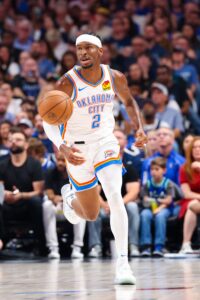 Shai Gilgeous-Alexander ($35,859,950)
Shai Gilgeous-Alexander ($35,859,950)- Luguentz Dort ($16,500,000)
- Chet Holmgren ($10,880,640)
- Kenrich Williams ($6,669,000)
- Cason Wallace ($5,555,880)
- Ousmane Dieng ($5,027,040)
- Jalen Williams ($4,775,760)
- Alex Caruso ($3,000,000)
- Total: $88,268,270
Non-Guaranteed Salary
- Alex Caruso ($6,890,000)
- Partial guarantee. Rest of salary noted above. Caruso’s salary will become guaranteed if he remains under contract through June 30.
- Jaylin Williams ($2,019,699)
- Adam Flagler (two-way)
- Total: $8,909,699
Dead/Retained Salary
Player Options
Team Options
Restricted Free Agents
Two-Way Free Agents
Note: Because he has finished each of the past two seasons on a two-way contract with the Thunder, Sarr’s qualifying offer would be worth his minimum salary (projected to be $2,168,944). It would include a small partial guarantee.
Draft Picks
- No. 12 overall pick ($4,950,480 cap hold)
- Total (cap holds): $4,950,480
Extension-Eligible Players
- Alex Caruso (veteran)
- Years and dollars will be limited until six months after the trade.
- Shai Gilgeous-Alexander (veteran)
- Gordon Hayward (veteran)
- Extension-eligible until June 30.
- Isaiah Joe (veteran)
- Team option must be exercised; extension-eligible as of October 16.
- Aaron Wiggins (veteran)
- Extension-eligible until June 30 (or beyond, if team option is exercised).
- Jaylin Williams (veteran)
Note: Unless otherwise indicated, these players are eligible for extensions beginning in July.
Unrestricted Free Agents
- Gordon Hayward ($49,350,000 cap hold): Bird rights
- Hayward’s cap hold will be either 35% of the 2024/25 cap or $49,979,096, whichever is lesser.
- Bismack Biyombo ($2,093,637 cap hold): Non-Bird rights
- Mike Muscala ($2,093,637 cap hold): Non-Bird rights
- Total (cap holds): $53,537,274
Cap Exceptions Available
Note: The Thunder project to operate under the cap.
- Room exception: $8,006,000
Luke Adams contributed to this post.
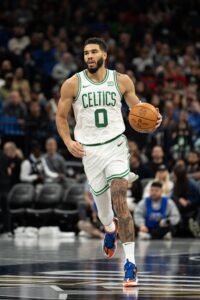 After adding
After adding 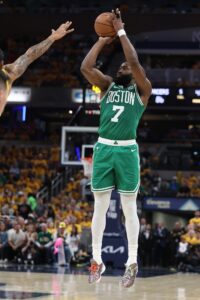
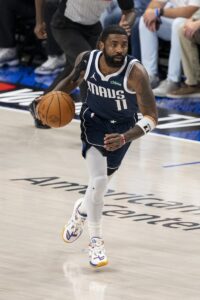 Buoyed by better chemistry between Doncic and Irving and the addition of rookie center
Buoyed by better chemistry between Doncic and Irving and the addition of rookie center 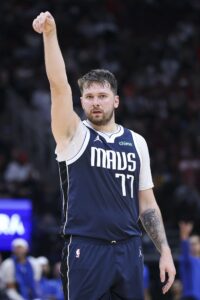
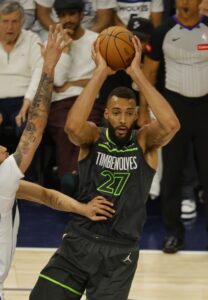 In their first season with Gobert, the Timberwolves took a step back, winning just 42 games after posting a 46-36 record in 2021/22, and the three-time Defensive Player of the Year struggled to adapt to his new situation. When the 2023 offseason got underway, there were myriad calls from pundits and fans for Minnesota to break up its frontcourt by trading either Gobert or (more likely)
In their first season with Gobert, the Timberwolves took a step back, winning just 42 games after posting a 46-36 record in 2021/22, and the three-time Defensive Player of the Year struggled to adapt to his new situation. When the 2023 offseason got underway, there were myriad calls from pundits and fans for Minnesota to break up its frontcourt by trading either Gobert or (more likely) 
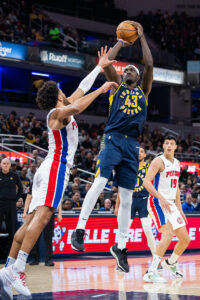 To continue getting better, the Pacers may have to rely mostly on internal improvement and tweaks around the margins. Haliburton’s All-NBA season means his maximum-salary rookie scale extension will begin at 30% of the 2024/25 cap (instead of 25%) and the club has already
To continue getting better, the Pacers may have to rely mostly on internal improvement and tweaks around the margins. Haliburton’s All-NBA season means his maximum-salary rookie scale extension will begin at 30% of the 2024/25 cap (instead of 25%) and the club has already 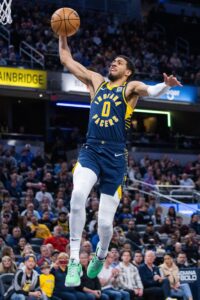
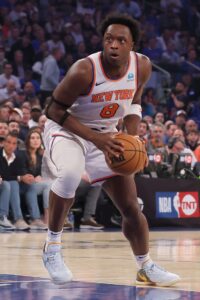 Re-signing Anunoby is an important first step for the Knicks this summer. The former Raptor is one of the NBA’s best three-and-D players – he has a .383 3PT% over the past five seasons and an All-Defensive nod under his belt – and his impact in his first 23 games as a Knick was undeniable. The team’s net rating during his 802 regular season minutes was an incredible +21.7. New York’s offensive rating (122.6) and defensive rating (100.9) during those minutes both would’ve ranked first in the NBA.
Re-signing Anunoby is an important first step for the Knicks this summer. The former Raptor is one of the NBA’s best three-and-D players – he has a .383 3PT% over the past five seasons and an All-Defensive nod under his belt – and his impact in his first 23 games as a Knick was undeniable. The team’s net rating during his 802 regular season minutes was an incredible +21.7. New York’s offensive rating (122.6) and defensive rating (100.9) during those minutes both would’ve ranked first in the NBA.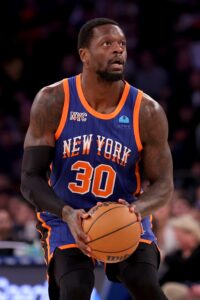
 The Thunder are
The Thunder are 
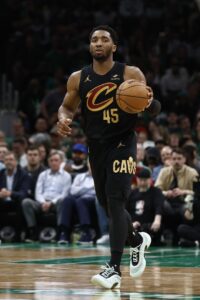 Now, there are a few caveats that make the Cavs’ season sound better than it appeared on the surface. They had to deal with a series of injuries affecting their most important players in both the regular season –
Now, there are a few caveats that make the Cavs’ season sound better than it appeared on the surface. They had to deal with a series of injuries affecting their most important players in both the regular season – 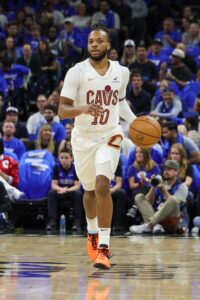
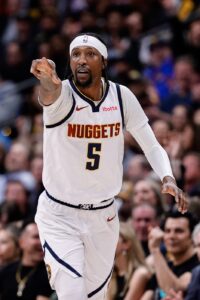 The Nuggets don’t need to overhaul their roster. The starting five of
The Nuggets don’t need to overhaul their roster. The starting five of 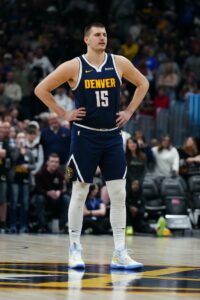
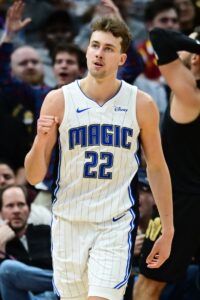 The good news for the Magic is that their young core is largely responsible for that surge up the standings. Orlando’s top three scorers in 2023/24 were
The good news for the Magic is that their young core is largely responsible for that surge up the standings. Orlando’s top three scorers in 2023/24 were 